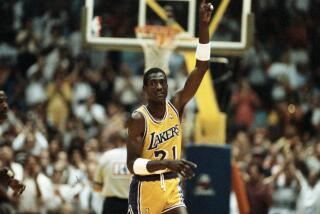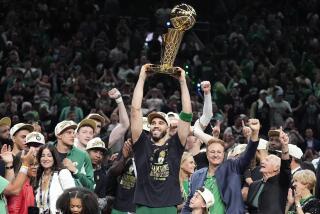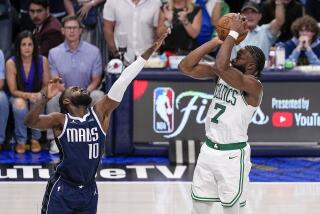Centers of Attention : For the Knicks There’s Ewing, For the Rockets There’s Olajuwon; Other Mates Are Distant Second
- Share via
Their recipe for success seems borrowed from a distant age, when winning a National Basketball Assn. title without leaning heavily on your center was as tricky as making an omlette without eggs.
The New York Knicks and Houston Rockets are chasing this year’s championship with an old-school formula. The big man, once again, is a big factor. For a while, he watched impatiently while the league turned into a trendy smaller man’s game. Leapers and three-point shooters and no-look passers reaped the NBA’s ultimate reward while post play became secondary and post players became complimentary.
Now, either the Knicks’ Patrick Ewing or the Rockets’ Hakeem Olajuwon will claim a ring later this month. Both are, by far, the best on their teams. There is Ewing and there is Olajuwon, and on those squads, every other player falls in line a distant second. There hasn’t been anything like this in a while. In fact, 16 years have passed since a center-dominated team won the NBA Finals.
Make no mistake--several great centers have won titles in that span. But they all had something in common. They all had tremendous teammates. Kareem Abdul-Jabbar and Robert Parish were surrounded by Hall of Fame help. Moses Malone didn’t win until he joined Julius Erving. Wes Unseld had the Big E.
You remove Ewing from the Knicks and Olajuwon from the Rockets, and you have the Sacramento Kings vs. the Washington Bullets.
This much is evident: The game has evolved once again. The revolution of the cycle is complete. A few eras ago, teams were only as good as their pivotmen. Nobody won championships without Russells or Chamberlains or Reeds or Waltons. Then came was a lengthy drought when guards and forwards--basketball’s equivalent to the welterweight division--steered their teams to championships. Today, half of this year’s serious championship contenders were center-oriented. And now, two have a chance to win a title.
This was destined to happen, once the Magic-Bird-Jordan years were officially over.
“This history of basketball has always been marked by a big man leading his team,” said Bill Walton, “with a 16-year exception.”
Walton was the last of his kind, a center with tremendous responsibility on a championship team. He was complemented by worthy and capable role players on the 1976-77 Portland Trail Blazers. They performed their specialized duties well enough.
“I was blessed with teammates who could catch my bad passes,” Walton says modestly.
But, truth is, everything hinged on the performance of Walton. He had to play superbly throughout the championship round in order for the Blazers to win.
“I wanted him to touch the ball on every possession,” said Jack Ramsay, who coached that Blazer team.
The Blazers’ entire offense was stamped with Walton’s signature. The Blazers ran a constant motion offense, primarily because of Walton’s passing skills, the best of any center before or since. He also had post-up and mid-range shooting ability, and was one of the better defenders of his time.
The Blazers beat the Philadelphia 76ers in six games, claimed the title . . . and then the NBA developed a new identity for the next 16 years.
Gradually, the skill positions began to dominate the scope. The impact of the center was lessened as the years passed. The Seattle SuperSonics won a championship based on backcourt play, with a clever point guard and a defensive-minded big guard. By the turn of the decade, Magic Johnson and Larry Bird suddenly were players that teams needed to win championships.
You may argue that, in his rookie season, Johnson wasn’t the focus of the Los Angeles Lakers. Abdul-Jabbar was. However, the Lakers wouldn’t have beaten the Sixers for the 1979-80 title if not for Johnson. Abdul-Jabbar, victimized by a severely sprained ankle, didn’t even suit up for the deciding game. Johnson assumed the major role, and his legendary Game 6 line--42 points, 15 rebounds and seven assists--lifted the Lakers to glory. The purists could only satisfy themselves with one thing about that game: At least Magic played center that day.
The rest of the ‘80s and the early ‘90s were noted for its complete blackout of the team-carrying center. The only center who came closest to fitting that description was Malone. On sheer determination, he single-handedly led the Houston Rockets to the 1981 finals, where they challenged the Boston Celtics. That’s when Malone uttered his famous quote, about how he “and four guys from Petersburg, Virginia” could whip the Celtics.
He discovered that four Celtics and Bird were much better.
In fact, Malone’s title chase proved futile until he linked himself with Erving and took the ’83 trophy.
From there, the center’s role on championship teams began to diminish, even on the great Celtic and Laker teams of the ‘80s. Bird was clearly the leader of the Celtics, and forward Kevin McHale was every bit as important as Parish. Abdul-Jabbar’s impact decreased with age, to the point where he occasionally was the third option on the last two Laker championship teams.
When the Celtic-Laker era ended, the Detroit Pistons won two consecutive titles with the three-guard rotation of Isiah Thomas, Joe Dumars and Vinnie Johnson, while center Bill Laimbeer was valued mainly for his intimidation and rebounding.
Then the center was removed almost entirely from the last three NBA Finals, all won by the Chicago Bulls and the game’s greatest player, Michael Jordan. What’s especially noticeable about that period is that the Bulls didn’t even face a team with an outstanding center in any championship series. They beat the Lakers and Vlade Divac, the Blazers and Kevin Duckworth, the Phoenix Suns and Mark West.
“The centers weren’t as good as the other players in that time period,” Walton said. “You win the championship with the best players, and for the most part, they weren’t centers. They were the Isiah Thomases, the Birds and the Johnsons.
“You had a period of time when so many of the big men who came into the league did so because they were big. They had to become good players.”
The game changed, too. It progressed from a half-court, ram-it-inside style to an up-tempo, fast-break pace that required athletes. Not many centers were built for baseline-to-baseline sprinting. The introduction of the three-point shot also placed a heavier value on the smaller man.
All of a sudden, every position on the floor was important, not just the one in the middle. On some teams, the big man was the weak link.
“What really helped the smaller player was his shooting ability from the perimeter,” Walton said. “The game back in the ‘60s was built around centers because they took the easiest shots. The shooting percentages of other players were low. Now, smaller guys have developed into great shooters. They began hitting the wide-open 20-footers, and you have to do that today or you’re not in this league for long.”
When the playoffs began a month ago, center-dominated teams littered the field. There was Shaquille O’Neal in Orlando, David Robinson in San Antonio and Dikembe Mutombo in Denver, along with Ewing and Olajuwon. With the exception of the first two, centers were the most visable and valuable players in the post-season.
The youthful Nuggets were successful mostly because of Mutombo. His defensive presence was immense throughout the playoffs. He snuffed the team with the NBA’s best regular-season mark by rejecting a record 31 shots by the SuperSonics. Then he put a scare into the Utah Jazz by disrupting their half-court style with 38 blocks, breaking his own record in the process. Mutombo invoked the same style that Bill Russell used during the Celtics’ run of championships in the ‘60s. He left the scoring to others while he concentrated on the elements that produced the end result--blocking shots, grabbing rebounds.
The Suns, last year’s Western Conference champion, were simply Hakreemed. While Charles Barkley disintegrated from back and groin injuries, Olajuwon produced 37 points and 13 rebounds and dusted off Phoenix in Game 7 of their semifinal series.
As the same time, Ewing was busy helping the Knicks dispatch the Bulls, their nemesis of recent playoff years. With Jordan retired, Ewing was expected to push the Knicks past the Bulls, and that was accomplished after a struggle.
“I feel like it’s finally my time,” Ewing said.
Neither Ewing nor Olajuwon is blessed with a great point guard, and that’s the most astonishing factor in their ascent this season. Most centers, the good and not-so-good, usually require a decent point guard who can deliver the ball. The Rockets and Knicks have point guards by committee. Still, the lack of an outstanding point guard hasn’t disrupted either center.
One reason lies with the perimeter shooting ability of both centers. When the lanes become clogged with the double- and triple-team defenses, both players can step outside and sink the 18-footer. Therefore, it’s not necessary that they rely on a point guard on every ball possession.
More than any other player, Ewing’s championship chances were damaged by Jordan. Three times in the previous four seasons, Ewing and the Knicks were eliminated by the Bulls. All that changed with an October news conference in suburban Chicago. When Jordan muttered two magical words--”I’m retired”--Ewing’s window of opportunity was pushed wide open.
“If Jordan was still here, he’d carry the Bulls past New York and everyone else,” said Pat Williams, the Orlando Magic president. “He would not let his team lose to the Knicks, and once he reached the finals, Jordan was as unstoppable as anyone. So I’d say, as much as anything else, Jordan’s retirement will be responsible for a great center winning this year’s championship.”
The Rockets are completely built around Hakeem. The defensive attention he attracts makes it easier on his teammates. He allows Vernon Maxwell and Kenny Smith to get open three-point shots. He enables forward Otis Thorpe to roam inside for rebounds.
He had a chance to win an NBA championship before. But, like Ewing, he fell victim to one of the great non-centers of the ‘80s. Eight years ago, two Rocket centers--Olajuwon and 7-foot-4 Ralph Sampson--were not enough to overcome Bird.
What has helped Olajuwon is his resiliency. Rather than try to beat Bird and Magic Johnson in their prime, Olajuwon simply outlasted them. And he actually became a better player during the waiting period, sharpening such skills as passing and jump-shooting to become the best player in the game.
“His game has developed over the years,” Rocket Coach Rudy Tomjanovich said. “It’s amazing how far he’s come. He was really pretty raw when he got to America (in 1980), but now he’s got the power and the quickness. He can beat you with the finesse game, going outside. He can play big, strong guys in the middle or drift out on a guard and use his quickness. It’s really a great story about how far he’s come.”
Not coincidently, Olajuwon became the first center to win the league’s Most Valuable Player trophy since Malone in ‘82-83.
“He’s the best center this game has seen in quite a while,” Ramsay said. “He can do so many things to dominate a game. Olajuwon is incredible. You can’t stop him. Teams will double him and he gets his shot off before the double comes. Or he’s passing it out to wide-open teammates. Olajuwon always finds a way to beat you.”
It would be only fitting for a dominant center to win this year’s title. They have won everything else this season. Robinson claimed the scoring crown and became the first center to do so since Bob McAdoo nearly 20 years earlier. Robinson finished just ahead of O’Neal. And in the MVP race, four of the top five vote-getters were centers, with Olajuwon finishing ahead of Robinson.
The trend throughout the league this year was defense and half-court offense. Both aspects placed a heavier emphasis on center play. It’s no surprise that the Knicks and Rockets excelled in the style that was favored by most teams this season.
“The game is really changing,” said basketball TV analyst Doug Collins. “You’re not seeing as many fast-breaks. You’re seeing more possession basketball. The possibility of Patrick and Hakeem getting together is exciting. You’re seeing the big man start to become a major part of things again. With Magic, Bird and Isiah gone, we’ve lost some of the most dominant creators on the perimeter in the last couple of years. Centers are taking their place.”
More to Read
Go beyond the scoreboard
Get the latest on L.A.'s teams in the daily Sports Report newsletter.
You may occasionally receive promotional content from the Los Angeles Times.










